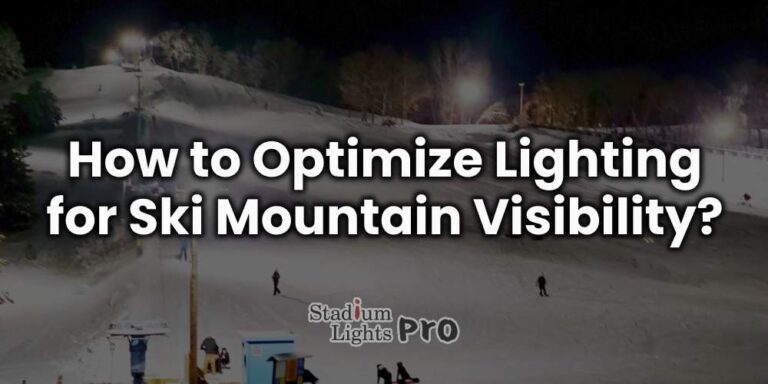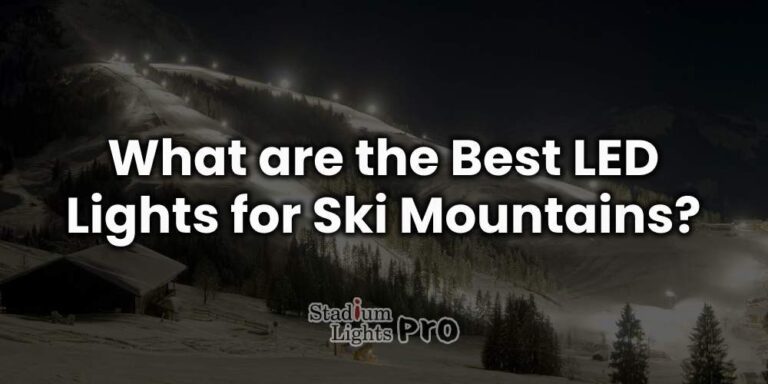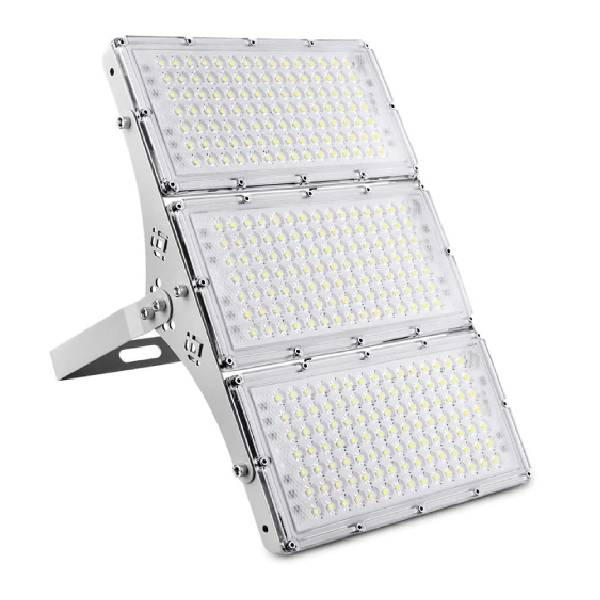
Ski Slope Lighting
Welcome to the pinnacle of illumination innovation of Ski Slope Lighting. Few activities rival the exhilaration of skiing down snow-covered slopes. Yet, as daylight fades and the shadows lengthen, the challenge of navigating the terrain becomes increasingly daunting. That’s where LED Ski Slope Lighting comes into play, revolutionizing the way skiers experience the mountains after dark.

Night skiing has expanded the possibilities for ski resorts, allowing longer operating hours and a unique experience for enthusiasts who enjoy gliding through snow under the stars. Proper lighting on ski slopes doesn’t just make this possible—it shapes how skiers see the terrain, perceive distance, and navigate turns. The environment presents challenges that are unlike most sports venues, and the lighting system must adapt to cold, elevation, varied slope gradients, and safety requirements. This article explores how lighting systems are designed for ski slopes, the characteristics of the luminaires involved, and several considerations that influence performance, safety, and energy use.
Contact us for a free lighting consultation
Table of Contents
ToggleLighting Design for Ski Slopes
Required Illumination Levels (Lux)
| Slope Type | Lux Level (Average) | Uniformity Ratio (Uo) | Number of Lights (per area) | Color Temperature |
|---|---|---|---|---|
| General Recreational Slope | 30 – 50 lux | 0.6 – 0.8 | Moderate (depends on slope size) | 3000K – 4000K (Warm White) |
| Advanced Ski Runs / Racing Tracks | 75 – 100 lux | 0.7 – 0.9 | High (higher pole density) | 4000K – 5000K (Neutral White) |
| Night Skiing (Beginners or Light Traffic) | 20 – 30 lux | 0.6 – 0.7 | Low (fewer fixtures needed) | 3000K – 4000K (Warm White) |
| Competition Slopes (High Visibility) | 100 – 200 lux | 0.8 – 0.9 | Very High (dense fixture coverage) | 4000K – 5000K (Cool White) |
| Freestyle Terrain (Parks and Jumps) | 50 – 70 lux | 0.7 – 0.8 | Moderate to High (strategic placement) | 4000K – 5000K (Cool White) |
| Cross-Country Trails | 20 – 40 lux | 0.5 – 0.7 | Low to Moderate (minimal coverage) | 3000K – 4000K (Warm White) |
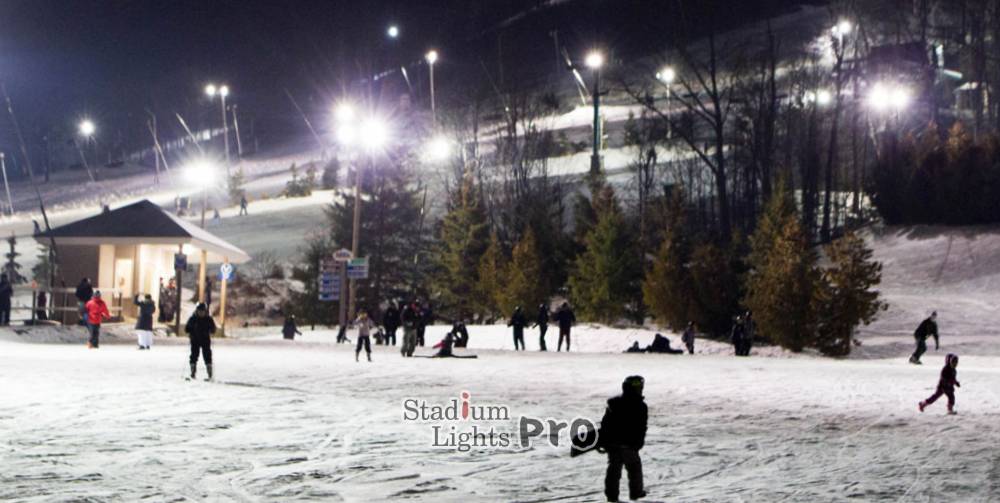
Lighting levels on ski slopes must cater to a range of users—from casual night skiers to professional athletes competing under the scrutiny of cameras. The required lux values depend heavily on the slope’s classification and intended use. Recreational slopes generally require an average illumination between 30 and 50 lux, ensuring sufficient visibility for safe and enjoyable skiing without overwhelming the senses.
In contrast, advanced or competition-grade slopes, especially those used for slalom, downhill racing, or televised events, may require over 100 lux, depending on broadcasting standards and national sports regulations. These figures refer to the horizontal illuminance measured directly on the snow surface, not just in the air.
One of the biggest design challenges arises from the high reflectivity of snow. With an albedo that often exceeds 80%, snow acts like a giant mirror, bouncing a significant portion of the light back toward the skier. Over-lighting can easily become uncomfortable or even visually disorienting, so finding the correct balance is not just about meeting numerical lux targets—it’s about achieving usable, comfortable light across variable terrain.
Uniformity of Light Distribution
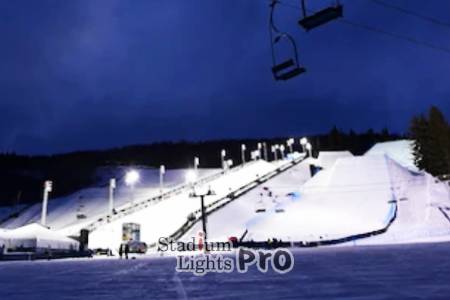 In a ski environment where the terrain constantly changes—featuring dips, moguls, banks, and turns—consistent light distribution is vital. Uneven lighting, where bright and dim spots alternate, can confuse skiers and reduce reaction time, especially during descents or jumps.
In a ski environment where the terrain constantly changes—featuring dips, moguls, banks, and turns—consistent light distribution is vital. Uneven lighting, where bright and dim spots alternate, can confuse skiers and reduce reaction time, especially during descents or jumps.
Light uniformity is evaluated using two main ratios: the minimum-to-average (U1) and minimum-to-maximum (U2) illuminance. A U1 ratio of at least 0.4 and a U2 ratio above 0.6 are generally the baseline targets for recreational slopes, while competitive tracks may demand higher uniformity to meet regulations and ensure visual clarity.
Achieving these ratios requires more than just choosing the right lights. Pole height, distance, and aiming angles must be precisely calculated. Inconsistent pole spacing or improper alignment can cause hotspots or shadowed zones, both of which are detrimental to skier performance and safety. Particular attention is needed near lifts, slope junctions, and terrain transitions, where poor lighting can increase collision risks.
Number and Placement of Lights
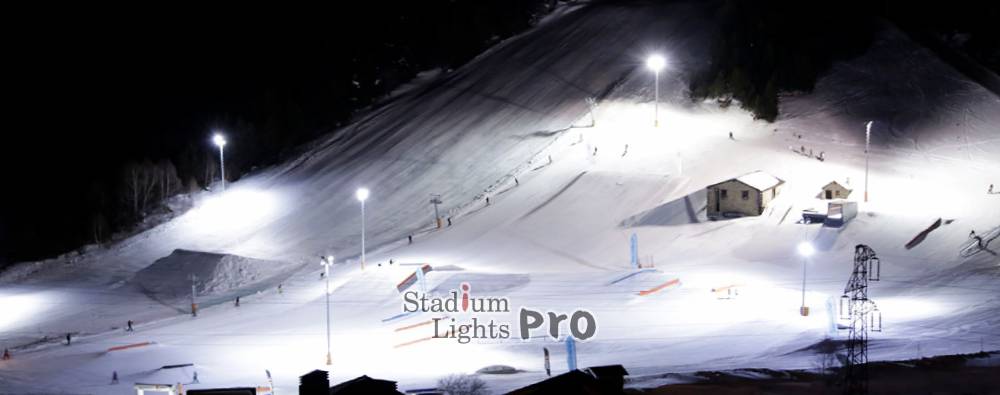
There is no fixed formula for the number of lights required on a ski slope—it depends on slope length, width, elevation profile, beam angle, and desired lux level. On typical recreational slopes, 20 to 40 high-power LED floodlights may be enough. However, longer or more complex slopes could require 100 or more strategically placed fixtures.
Designers often choose between asymmetrical lighting, where lights are placed on one side of the trail, and symmetrical lighting, where fixtures are installed on both sides. For wider slopes or areas with significant elevation variation, symmetrical layouts usually provide better coverage, minimizing shadowing and improving uniformity.
The placement strategy must also account for snow grooming equipment, skier movement, wind patterns, and available infrastructure. Poles need to be accessible for maintenance yet not obstruct skier flow or create risks during snowstorms or heavy winds. Sophisticated 3D lighting simulations help engineers model beam distribution across uneven snow surfaces, refining layouts to prevent dark corners or overlapping spill.
Power Efficiency and Energy Consumption
Lighting is a major energy consumer in ski resorts, where electricity distribution is already costly and complicated due to altitude and climate. Energy efficiency is therefore a financial and operational priority. The widespread adoption of LED lighting technology is driven by its superior luminous efficacy, with modern units producing between 130 and 180 lumens per watt.
Beyond fixture performance, efficiency is also affected by system-wide choices. Using smart drivers, dimming functions, and occupancy controls, operators can adjust lighting levels based on real-time needs. For example, slopes can be dimmed during low-traffic hours or when only used by staff for maintenance. Some resorts have implemented sensor-driven lighting, which automatically brightens specific zones when skiers are detected and dims them afterward, optimizing both safety and cost.
Moreover, lighting zones can be programmed to respond to skiing schedules or emergency scenarios. By turning off unused areas or responding dynamically to weather conditions, such systems significantly reduce energy waste while keeping the slope safe and enjoyable.
Color Temperature and Visual Comfort
Snow changes how we perceive color and contrast. A poorly chosen color temperature can lead to visual fatigue or confusion, especially when moving at high speeds. Warmer tones in the 3000K range are often too soft and can make depth and edges harder to judge. For ski slopes, cooler color temperatures between 4000K and 5700K are ideal, offering higher contrast and crisper shadows that help define terrain features.
Color rendering index (CRI) is another factor to consider. While a CRI of 70 or above is typically sufficient, some high-end applications—such as international competitions or video capture—may require CRI ratings over 80 to ensure visual accuracy in both real-time and playback formats.
Proper color selection isn’t just about brightness. It’s also about comfort. Overly bluish light (above 6000K) can appear harsh, making the landscape feel artificial or icy cold. The ideal compromise lies in a neutral white light that offers both depth perception and visual warmth, helping skiers feel comfortable and alert.
Glare Control and Visual Safety
Glare is a frequent complaint in ski slope environments. Whether it’s direct glare from the fixture or reflected glare bouncing off the snow surface, it can impair a skier’s ability to perceive obstacles or judge distances, particularly at high speeds.
To minimize glare, lighting systems use a combination of optical shielding, proper aiming, and cut-off techniques. Fixtures are often designed with narrow beam angles and shielded housings, directing light only where it’s needed. Mounting lights at elevations over 10 meters also helps diffuse the beam and reduce the angle of incidence, which can otherwise create blinding reflections.
Correct aiming angles and fixture spacing are essential. Lights that are misaligned or placed too low may throw beams directly into the eyes of skiers or passengers on ski lifts. Conversely, over-tilting fixtures can produce light pollution and sky glow, which are environmental concerns for mountain resorts.
Lighting Control and Automation
One of the most powerful trends in ski slope lighting is the rise of smart control systems. These allow ski resorts to automatically manage lighting intensity, schedules, and zones with minimal human intervention. Lights can be pre-programmed to operate based on sunset and sunrise, specific event times, or even real-time skier presence detected via sensors or cameras.
Operators benefit from centralized dashboards, where they can view system status, adjust light levels, and receive maintenance alerts. When integrated with resort-wide management software, lighting controls can react to snow conditions, fog density, or emergency protocols. For instance, lights can be brightened during snowfalls to improve visibility or dimmed during clear moonlit nights to conserve power.
Many systems also allow remote diagnostics and firmware updates, reducing the need for technicians to manually access each light pole. This feature is especially useful in hard-to-reach alpine environments, where maintenance can be both dangerous and expensive.
Characteristics of Ski Slope Lights
Cold Weather Resistance and Durability
Ski slope lighting systems must be built to withstand extreme cold and rapidly changing weather conditions. Luminaires designed for ski resorts are expected to perform in subzero temperatures, often dipping to -30°C or lower. This sets them apart from standard industrial lighting fixtures, as the internal components of ordinary LEDs or halogen bulbs may not survive the freezing temperatures, leading to premature failure.
High-performance LED lights used for ski slopes are engineered with materials that can handle thermal cycling—the repeated freezing and thawing cycles that occur as temperatures fluctuate. These fixtures are designed with robust die-cast aluminum housings, which help in maintaining structural integrity and corrosion resistance. Sealing components like silicon gaskets and anti-corrosive coatings prevent moisture ingress, which could lead to failure under wet conditions, especially when exposed to snow, ice, or rain. In some advanced designs, integrated thermostats and heating elements are used to regulate the temperature of the internal electronics, ensuring they remain within operational limits even in the harshest conditions.
These durable materials and technologies ensure that ski slope lighting systems continue to function properly for years despite the severe cold.
Resistance to Snow and Ice Buildup
In snowy environments, light fixtures can accumulate snow and ice on the lens or housing, reducing light output and distorting the beam shape. As a result, preventing this buildup is a significant challenge for ski slope lighting systems. Snow and ice accumulation can drastically affect the visual clarity and performance of the lighting, especially in environments where heavy snowfall is common.
To combat this, downward-sloped housings are used to direct snow and ice away from the fixture. Heated lenses or hydrophobic coatings are also utilized to prevent the buildup of moisture, which can accumulate and freeze on the lens surface. These features help ensure that the fixtures maintain their optical clarity and continue to provide consistent light output even in the snowiest conditions.
The materials chosen for the lenses—such as polycarbonate or tempered glass—also play a crucial role in resisting snow and ice buildup. These materials are frequently treated with anti-icing coatings to enhance their performance in extreme cold. In addition, the placement of fixtures is carefully considered to reduce the risk of snow accumulation, such as ensuring they are positioned away from areas prone to heavy snow spray from grooming equipment or skier traffic.
Vibration and Wind Load Tolerance
Ski slopes are often located in high-altitude, windy environments, and the lighting fixtures must withstand these extreme weather conditions. Strong winds, snow pressure, and even the risk of avalanches in some regions demand that ski slope lights are built to endure these stresses. Without proper engineering, these forces could cause fixtures to loosen, rotate, or even become damaged over time.
To mitigate these risks, vibration-resistant brackets, locking mechanisms, and impact-resistant casings are integral to modern ski slope lights. These features prevent fixtures from being dislodged during harsh weather, ensuring that the light remains focused on the ski slope and continues to function properly. Additionally, some ski resorts use guyed masts or reinforced concrete poles to further protect fixtures from extreme wind loads and prevent fatigue caused by continuous exposure to high winds and freeze-thaw cycles.
Mounting systems that include tilt-locking or shock-absorbing mechanisms provide added stability, ensuring that the beam angles of the fixtures remain intact even during windstorms or other environmental stresses. This design approach enhances the longevity and safety of the lighting system.
Long Lifespan and Low Maintenance
Given the remote locations of many ski resorts and the challenging environmental conditions, long lifespan and low maintenance are paramount considerations in the selection of lighting systems. Unlike traditional metal halide or high-pressure sodium lamps, modern LED lights used for ski slope lighting systems can last for up to 50,000 to 100,000 hours—far exceeding the lifespan of older lighting technologies.
This extended lifespan reduces the frequency of maintenance and replacement, which is particularly important in remote or high-altitude locations where maintenance is costly and logistically difficult. Additionally, self-cleaning designs, sealed optics, and surge-protected drivers help extend the service life by protecting components from dust, moisture, and electrical surges, which could otherwise cause premature failure.
The integration of remote diagnostics through smart controllers is also a key factor in maintaining a long-lasting lighting system. These systems enable operators to monitor fixture performance and detect issues like dimming failures, driver malfunctions, or even potential weather-related damages without needing to physically inspect each light pole. This is a major time-saver, especially when dealing with hard-to-reach fixtures in challenging environments.
These long-lasting, low-maintenance features significantly reduce the operational costs associated with ski slope lighting and ensure that the slopes remain well-lit, safe, and reliable year after year.
Additional Considerations for Ski Slope Lighting
Environmental Impacts and Light Pollution
When designing lighting systems for ski slopes, it is crucial to consider the environmental impact. Ski resorts are often situated in pristine mountain ecosystems that are highly sensitive to artificial light. Excessive light spill can disrupt wildlife, particularly nocturnal species, and interfere with natural behaviors such as feeding, mating, or migration. Additionally, the skyglow caused by uncontrolled lighting can obscure the natural beauty of the night sky, impacting both ecological and aesthetic values in alpine areas.
To mitigate these impacts, many regions require ski resorts to adhere to dark-sky regulations that aim to preserve natural darkness. Ski slope lighting systems often incorporate full-cutoff luminaires, which direct the light precisely where it is needed and prevent upward light spill. The use of optical shielding and narrow beam angles helps control the light distribution, further reducing the environmental footprint. In some ski resorts, the lighting strategy involves selective lighting zones, where only certain sections of the slope are illuminated, leaving other areas in complete darkness to minimize the disruption to the local ecosystem.
By carefully considering the environmental effects of ski slope lighting, resorts can strike a balance between safety and environmental responsibility, allowing visitors to enjoy the slopes while preserving the natural beauty of the mountain surroundings.
Emergency and Backup Lighting
Safety is a top priority in ski resorts, especially during night skiing or rescue operations. Given the remote location of many ski slopes, redundant systems are often incorporated into the lighting design to ensure that emergency lighting remains operational at all times. If there is a power outage or a system fault, backup generators, battery packs, or secondary circuits are used to keep essential lights functioning. These systems ensure that ski slopes are adequately illuminated during emergency situations, such as nighttime rescues or when visibility is low due to adverse weather conditions.
In addition to the primary lighting system, some poles are equipped with emergency beacons or directional lights to help patrol teams and rescue personnel navigate the slope more easily during night rescue missions. These lights are often designed to be highly visible and act as guiding beacons for rescue operations. With these backup measures in place, the safety of skiers and resort personnel is ensured even in the event of unexpected disruptions.
Integration with Other Resort Infrastructure
Ski slope lighting does not operate independently; it must be coordinated with other resort infrastructure to ensure efficient energy use and ease of maintenance. The lighting system should be designed in conjunction with other electrical systems, such as lift stations, snow cannons, grooming equipment, and resort pathways, to streamline power distribution and avoid overloading circuits.
In many ski resorts, the lighting system is integrated with lift operations, meaning that lighting can share distribution panels and trenching routes with lift cables and other electrical lines. This not only reduces the installation costs but also simplifies maintenance over time. By planning the layout and power distribution carefully, ski resorts can ensure that the electrical systems are balanced and capable of supporting the lighting without unnecessary strain on the grid.
This level of coordination between the lighting system and other infrastructure allows resorts to manage power efficiently, reducing costs and minimizing the likelihood of electrical issues. Additionally, it provides flexibility for future upgrades or changes to the resort infrastructure, ensuring that all systems remain seamlessly integrated as the resort evolves.
FAQ – Ski Slope Lighting
What are the benefits of upgrading to LED lighting for ski slopes?
Upgrading to LED lighting for ski slopes provides numerous benefits over traditional lighting technologies such as metal halide or high-pressure sodium. LEDs are known for their energy efficiency, producing more light (lumens) per watt of power consumed than older technologies. This results in significant cost savings on electricity bills, especially in large ski resorts that operate lights for extended hours during the winter season. Moreover, LEDs have a much longer lifespan, typically lasting between 50,000 to 100,000 hours compared to the 10,000 to 20,000 hours of conventional lights. This extended life reduces the need for frequent replacements and lowers maintenance costs.
Another advantage is the ability of LEDs to provide high-quality, directional light. This reduces the amount of light spill into surrounding areas, minimizing environmental disruption and improving skier safety by providing clear, even lighting where it’s most needed. LEDs also have better color rendering properties, which enhance the visibility of terrain features like moguls, bumps, and track edges, especially at night. With the addition of smart dimming and control systems, energy usage can be adjusted based on time of day or skier traffic, further improving energy efficiency.
How do I determine the right lux levels for different slopes?
The right lux level (illumination level) for a ski slope depends largely on its intended use. For general recreational slopes where skiers are casually skiing or snowboarding, an average illuminance of 30 to 50 lux is typically sufficient to provide clear visibility. However, for more advanced slopes, such as racing tracks or areas used for televised events, the lighting may need to exceed 100 lux to meet the high visibility demands. Lighting design should also account for factors such as snow reflectivity and environmental conditions.
Snow is highly reflective, which can cause light to bounce back toward skiers, creating bright spots and glare. Because of this, it is essential to strike a balance between providing enough light to ensure skier safety while also preventing over-illumination, which could lead to discomfort. Lux levels should be measured on the snow surface, ensuring consistent illumination across the slope. The lighting design should be tailored to meet the specific needs of each area, considering whether the area is for casual skiing or competitive use.
What should I consider when placing lights on the slope?
Placing lights on a ski slope involves careful consideration of several factors such as the slope’s geometry, size, gradient, and terrain features. For example, wide slopes or those with steep gradients may require lights to be positioned on both sides to provide even coverage and reduce shadows. In such cases, a dual-side configuration may be ideal. The height of the poles, spacing between fixtures, and the beam angles of the lights all need to be tailored to the unique features of the slope.
The goal is to ensure that lighting is uniform and avoids creating dark spots that could impair visibility, especially in areas with sharp turns, elevated sections, or grooming paths. Pole height and spacing will depend on the desired lux levels and the coverage area. For example, on shorter slopes, fewer lights with wider beam angles may be sufficient, while longer slopes or competitive runs may require a larger number of fixtures with narrower beam angles to ensure adequate illumination. The design must also factor in access for maintenance, wind exposure, and the potential for snow or ice buildup.
What is the impact of snow reflectivity on ski slope lighting?
Snow has a high level of reflectivity, known as albedo, which means it bounces light back toward the skier. This can result in intense glare, which not only reduces visual comfort but also impairs depth perception and terrain recognition. The high reflectivity of snow means that light intensity can appear stronger than it actually is, leading to potential discomfort or visibility issues for skiers, particularly during bright or direct lighting conditions.
To address this, lighting design should account for the reflective nature of snow by carefully selecting appropriate lux levels and optimizing fixture placement. In many cases, lighting should be balanced to avoid over-illumination, especially in areas with dense snow coverage. Beam angles and fixture shielding can help reduce direct glare by ensuring the light is directed properly without being scattered by the snow. Maintaining proper light distribution is key to ensuring visibility without causing discomfort or hazards due to excessive brightness.
How can I reduce energy consumption with ski slope lighting?
Energy consumption is a significant consideration for ski resorts, as lighting often represents a large portion of operational costs. To reduce energy usage, resorts can make use of high-efficiency LED fixtures which offer a much higher luminous efficacy than traditional lighting options. This means less electricity is required to produce the same amount of light.
Additionally, integrating smart control systems can help optimize energy use. Systems that include motion sensors, dimming controls, or time-based adjustments can automatically reduce light levels during low-traffic periods or non-operating hours. Ski slopes can also use zoning in lighting control, allowing only certain areas to be illuminated based on skier density or schedule. For example, if only certain trails are being used at night, those areas can be lit while others remain off to save energy. This type of dynamic lighting not only improves energy efficiency but also reduces operating costs without compromising skier safety.
How do I prevent glare from ski slope lighting?
Glare is one of the most challenging aspects of ski slope lighting, as it can hinder visibility and create dangerous conditions for skiers. The reflective snow surface exacerbates glare, and the combination of high-powered lights and snow can create intense brightness in areas where it’s not needed. To manage glare, it’s crucial to use shielded optics in the fixtures, which direct light downward and prevent unnecessary light spill into the skier’s line of sight.
Another method is to incorporate cut-off angles and directional beam control, which ensures the light is focused only on the areas that require illumination. Positioning the lights at higher mounting heights (typically above 10 meters) can also help reduce glare by increasing the angle of incidence. Proper beam aiming also helps prevent light from bouncing directly into the skier’s eyes, minimizing glare and improving visual clarity. Furthermore, using low-glare LEDs and controlling the intensity and distribution of light can significantly enhance skier safety, especially in high-speed areas.
What is the expected lifespan of LED lights used on ski slopes?
LED lights are known for their long lifespan, often lasting between 50,000 to 100,000 hours. This is much longer than traditional lighting technologies like metal halide or high-pressure sodium, which typically last only 10,000 to 20,000 hours before requiring replacement. The extended lifespan of LEDs is particularly beneficial for ski slopes, where lights are exposed to harsh winter conditions, including extreme cold, snow, and wind.
Because of their long operational life, LED lights help reduce maintenance costs and the need for frequent replacements. In addition, LEDs maintain their luminous output throughout their lifespan, ensuring that the lighting levels remain consistent without a drop in performance over time. This reliability is especially crucial for ski slopes in remote locations, where regular maintenance can be logistically challenging.
How do I handle snow and ice buildup on light fixtures?
Snow and ice accumulation can obstruct the output of lighting fixtures, leading to uneven illumination and potential maintenance issues. To handle snow and ice buildup, ski slope lighting fixtures are often designed with anti-icing features. Heated lenses, downward-sloped housings, and hydrophobic coatings are commonly used to prevent snow and ice from accumulating on the fixtures.
Additionally, lens materials such as polycarbonate or tempered glass can be treated with special anti-icing coatings to help maintain optical clarity. Proper placement of the fixtures can also help minimize the effects of snow and ice buildup. For example, locating lights higher up on poles can reduce the amount of snow spray they receive from grooming equipment or skiers. Regular maintenance is also essential to clear any ice or snow that may have accumulated on the fixtures, especially in areas that are heavily exposed to wind and snow.
What are the key considerations for ski slope lighting in cold climates?
Ski slopes are typically located in areas where temperatures can reach subzero conditions. Therefore, lighting systems must be designed to withstand extreme cold without malfunctioning. Fixtures must be rated for cold-weather operation, which means that components should be able to handle the stresses of thermal cycling (frequent temperature fluctuations) without cracking or degrading.
LED fixtures for cold environments are typically made from die-cast aluminum or other materials that are resistant to corrosion from snow and ice. Sealed optics and corrosion-resistant coatings ensure the lights remain operational despite exposure to the elements. In some cases, thermostats or heating elements may be integrated into the fixture to ensure internal electronics remain within operational temperature ranges. These cold-weather-rated fixtures are crucial for maintaining consistent performance in the challenging conditions often found on ski slopes.
How can ski slope lighting be integrated with other resort infrastructure?
Ski slope lighting systems don’t operate in isolation; they need to be integrated with other infrastructure on the resort, such as lift stations, snow cannons, grooming equipment, and resort pathways. Integrating lighting with these systems helps streamline power distribution, reduces installation costs, and simplifies maintenance.
One way to achieve integration is by using shared power distribution panels and trenching routes for both lighting and other resort systems, which reduces the need for multiple electrical circuits and simplifies infrastructure planning. Coordination is crucial to avoid overloading electrical systems and ensure efficient power use across the resort. By designing a unified electrical infrastructure, ski resorts can ensure that lighting and other essential systems are both reliable and cost-effective, improving the overall operational efficiency of the resort.
Conclusion
Lighting transforms a cold, snowy slope into a vibrant nighttime playground. From weekend recreation to international competitions, the quality and design of ski slope lighting directly affect safety, visual performance, and operational efficiency. With advanced LEDs, precision optics, and intelligent controls, ski resorts can now create illuminated environments that are visually stunning, energy-conscious, and highly functional.
The engineering behind ski slope lighting is both technical and creative, demanding a mix of environmental awareness, electrical strategy, and user-focused design. As night skiing grows in popularity and expectations rise, well-designed lighting systems will continue to define the experience, guiding skiers down the slopes in clarity and confidence long after the sun sets.


